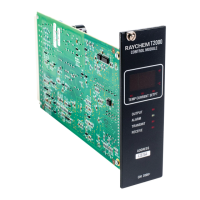nVent.com | 11
1.5 AC 2000+ CARD OVERVIEW
1.5.1 DESCRIPTION
The AC 2000+ alarm/communications interface card has similar functionality to the original
AC 2000 Alarm/Communications interface card, but also combines the features of a Group
Communications Controller (such as a Model 780/GCC-9000).
The AC 2000+ is designed to automatically poll all of the installed control modules for alarm
data as well as maintain a database of their setpoints, setup parameters, alarm and analog
data. Note that all control operations are performed by the CM 2000/CM 2000+ control
modules and not by the AC 2000+.
The user may configure setpoint or setup parameters for up to (40) CM 2000 and up to (256)
CM 2000+ control modules by using any of the AC 2000+ ports. The AC 2000+ communicates
with the control modules through the backplane of the CR 2000/CR 2000+ card rack(s).
IMPORTANT: The AC 2000+ belongs to a family of Group Communications Controller
(GCC) devices. While specific to the RAYCHEM T2000 series of products, the AC 2000+ is
nonetheless a Group Communications Controller (GCC). This nomenclature will be used
through this user manual.
1.5.2 FEATURES
A detailed description of available features supported by the AC 2000+ alarm/communications
interface card may be found in Section 7 of this manual. The following descriptions highlight
specific features of the AC 2000+:
Port Configuration
All of the communications port configuration parameters of the AC 2000+ may be reviewed
or modified via the local front panel RS-232 port using a PC running the “Communication
Controller Configuration Utility” program (see Section 1.5.3).
Communication Ports
All RAYCHEM T2000 HTC parameters and data may be reviewed and modified through the
following three communication ports of the AC 2000+:
1. Remote Port: This isolated RS-485 serial port allows up to (31) AC 2000+ devices to be
multi-dropped onto the same pair of RS-485 communication wires and then connected to a
remote upstream programming device such as a host computer, PLC or DCS.
2. Local Port: This serial port may be configured to use either the front panel RS-232
interface or the 2-wire RS-485 interface on the back of a CR 2000+ card rack. Select the
RS-232 interface to connect with one Personal Computer, PLC or DCS in close proximity
totheAC2000+.SelecttheRS-485interfaceifanumberofAC2000+devicesaretobe
multi-dropped onto the same pair of communications wires and connected to a local
communications device.
3. Ethernet Port: This connection provides an industry-standard 10Base-T interface and
supports a Modbus/TCP connection. This port is typically used when remote monitoring and
configuration is required using an Ethernet Local Area Network (LAN).
Relay Driver Outputs
The AC 2000+ has two “fail-safe” outputs to drive external 12Vdc relay coils. One is used for
indicating “Alarm” conditions and the other for indicating “Warning” conditions.
Monitoring
The status of the AC 2000+, and all of the control modules are continuously monitored for
proper operation and various alarm conditions. Control module information includes discrete
setpoint, setup and alarm data, as well as analog values such as temperatures, currents, etc.
Tags
The AC 2000+ and each control module may be assigned an identification tag eliminating
confusing codes or cross-referencing. Tags may be up to 19 alpha-numeric characters in length.
Load Shedding
This is an advanced control mode, managed by the AC 2000+ alarm/communications interface
card. Load shedding overrides temperature control and forces the output of the selected
control modules off until reset by the AC 2000+. This mode is initiated by using a remote
Modbus command from an external upstream programming device. See Sections 3.4.18
to 3.4.20, 5.3, 7.4.2, 7.4.3, 7.4.6.7, and 7.4.7 as well as Appendix E in this manual for details
regarding the load shedding features and related parameters.

